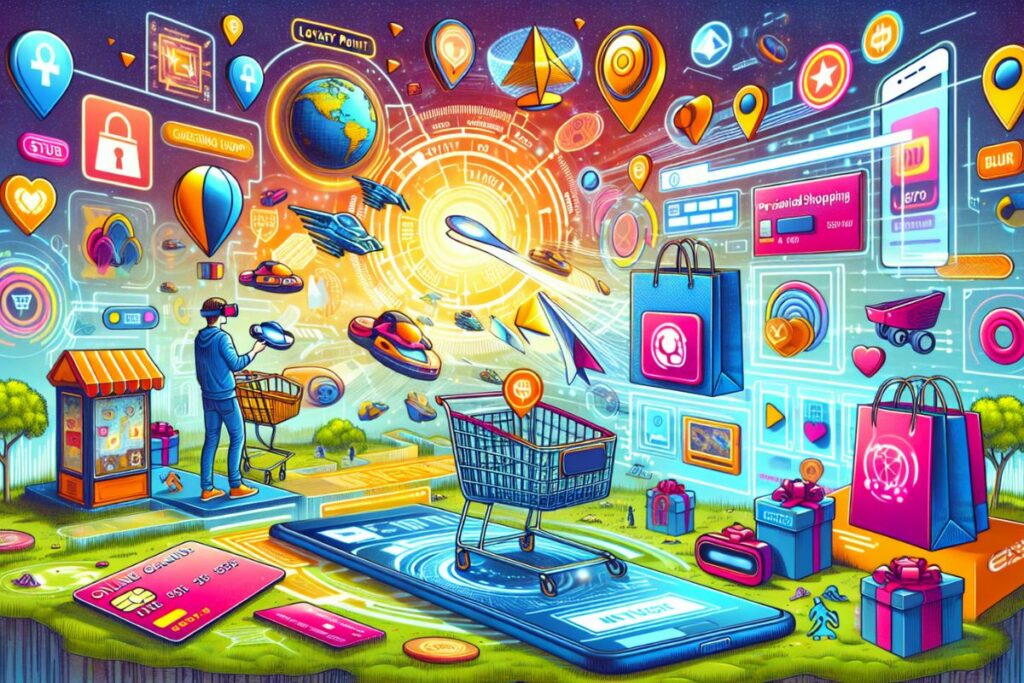SPONSORED ARTICLE
With cloud investment continuing and the rapid rise of GenAI, retail is on the cusp of another technological revolution that requires new thinking and a clear strategy.
The retail sector is on the brink of a technological renaissance, with innovations poised to redefine consumer and brand experiences across channels, unleash greater potential of employees and drive greater efficiency across the supply chain.
Key for retailers this year – and a central reason for their willingness to embrace new technology – is the need to generate revenue in a challenging market, find cost efficiencies to help maintain margins, and improve company culture.
The year is still young but already it is clear generative artificial intelligence (GenAI) and cloud technology are establishing themselves as the powerhouse technologies set to revolutionise the way retailers engage with customers and optimise their operations.
AI was the Collins Dictionary word of the year in 2023 as society embraced and explored what GenAI could offer, but 2024 looks set to be the year of wider deployment in retail.
Below, we look at how cloud and GenAI are driving positive change in retail, and assess the rest of the top five technologies and tech focus areas set to dominate the retail scene in the months ahead.
1. More adventures in the cloud
Retailer or not, most organisations currently consider the cloud as a technology platform, according to analyst firm Gartner, which says in 2023 cloud computing was used either as a “technology disruptor” or “capability enabler”.
But Gartner predicts that more than 50% of enterprises will use industry cloud platforms by 2028 to accelerate their business initiatives. By that time, most of them will be leveraging cloud as a business necessity – that’s the direction of travel, and it is certainly accelerating in retail in 2024.
Tech and AI powerhouse Microsoft talks of the four stages of digital maturity, beginning at “siloed retail” which is the result of retailers incrementally building their tech stacks over multiple decades to now find the data they need is spit across disparate systems.
As retailers look to do strategic work led by their data, they need it centralised and easily accessible for multiple stakeholders – and it’s prompting more of the industry to migrate systems to a cloud-based infrastructure.
This entails moving to “connected retail” and “analytics-driven retail”, and ultimately to “intelligent retail”, where an organisation can deliver experiences for its staff and consumers that integrate AI and machine learning into custom applications.
Retailers can judge for themselves where they are on that journey, but more are embarking on it, including etailer Asos, tech retailer Currys, and DIY group Kingfisher.
Susie Moan, chief data officer (CDO) at Currys, tells Retail Gazette: “You should always have a data strategy that is aligned to your business strategy.”
Moan has overseen the migration of data into Microsoft Azure while encouraging a data science approach within the organisation. Her team is also working on three internal proof-of-concepts using GenAI to gain business insights.
“Without the programme we’ve done to bring data together, we wouldn’t even be able to consider doing true GenAI,” she argues.
2. GenAI to play a greater role
Retail’s prospects going into the new year were good, according to analyst group Forrester, with consumers starting to show more confidence and a willingness to spend. Marks & Spencer, Boots,Tesco and Sainsbury’s all reported strong Christmas trading and a positive outlook for the 12 months ahead.
But with more confident and willing customers comes greater responsibility for retailers – and a need to meet rising demands.
Jitender Miglani, principal forecast analyst at Forrester, says as inflation cools and the European economy stabilises, retail sales in 2024 are expected to grow at pre-pandemic levels for the first time since the Covid crisis.
“To take advantage of this expected growth, European retailers need to focus on enhancing their digital presence, building supply chain resilience, and implementing customer-centric strategies,” Miglani explains.
The key things retailers and brands working with Microsoft are trying to harness in their AI implementations to date are small language models and multimodal GenAI.
Carrefour is a leading example of a retailer embracing GenAI to embellish customer experience (CX).
In June 2023 it deployed ChatGPT-based solutions to launch a natural-language AI chatbot that grocery consumers can ask for advice when selecting items. The bot is connected to the website’s search engine and presents relevant product lists.
More retailers are expected to roll out initiatives of this nature in the 12 months ahead – with fashion the leading retail sector in terms of growth in AI usage in recent months, according to Microsoft.
With increased competition online from fast-growth businesses such as Shein and Temu, which have gained significant market share in the last 12 months, retailers cannot stand still when it comes to their customer proposition – and utilisation of GenAI is a key enabler.
Use cases of AI usage in retail are quickly multiplying and diversifying, with a wider spread across supply chain, HR, back office, and commercial functions – as well as store and digital ones.
And according to Microsoft, the value of AI is becoming less obscure, with more grounded value hypotheses based on early signs of value from use cases in production.
3. Supply chain tech in focus
One disruption after another in the retail supply chain over the last decade means retailers know they need to reshape their whole value chain to bring the agility they need to navigate ongoing turbulent times in 2024.
The Red Sea crisis is the latest event causing supply chain challenges, disrupting the flow of goods from east to west since November – with many retailers expecting delays long into 2024.
Whether it is to deal with big international events or more internal challenges, retailers are increasingly realising work is required behind the scenes – be it investment in new shipping routes, order and inventory management systems or warehouse technology – to progress.
Many are turning to AI, cloud technology, and a data-led strategy to make improvements here.
In the supply chain, there is a focus on resiliency and visibility, with retailers investing in creating a continuous bidirectional exchange of information with suppliers.
Asos CEO, José Antonio Ramos Calamonte, wrote in the company’s annual report in November 2023 of the need to reduce supplier partners and increase the speed to market of the most popular product lines to drive sales, reduce overstock, and enhance efficiency.
He said a key focus area is to eliminate “bad returns” from unprofitable customers and avoidable circumstances such as poor quality or inaccurate sizing.
“We will constantly strive to eliminate bad returns by closer scrutiny of returns data to identify high returning products, brands or materials and taking corrective action and improving the size, fit and quality of our products alongside AI forecasting to drive better decision-making,” Calamonte stated.
We can expect more retailers to undertake similar work and to introduce the latest technologies to optimise this crucial part of the value chain.
4. ESG-related software investments
From Schuh to Brooks Running and from Reiss to River Island, retailers from all sectors are investing in software to help increase traceability and transparency in their supply chains.
Much of this work is due to a growing need to make improvements from an environmental, social, and corporate governance (ESG) perspective.
They can’t manage what they don’t measure – and there is huge focus across the retail industry to map out their supplier base, which requires significant investment and partner collaboration.
This work is only set to become more important in 2024 as new legislation comes into play, including the need to set net zero targets, continue general reporting on ESG progress, and get to grips with the ongoing stream of new policies around packaging, waste, materials sourcing, and other legislation.
5. Tech in the hands of retail staff
More tech in the hands of staff is set to be a feature of 2024 – from front-line workers using mobile devices to better serve their customers, to head office staff using GenAI to speed up how they manage documents.
A case in point is L’Oreal’s in-store beauty advisers, who use Microsoft Teams to stay connected to each other and to head office, while also managing several HR tasks. All of which empowers them to be productive and enhance their customer interactions.
In the US, Walmart rolled a My Assistant tool to all non-store employees in August 2023, via the company’s employee app. It allows them to accelerate draft writing, can summarise large documents, and will increase its functionality as the year progresses.
Currys is also trialling the use of GenAI in its head office to crunch data quicker.
Moan says GenAI is being used to assess customer sentiment, particularly around delivery.
“It’s the feedback we get from three different forms on what customers say – it’s a case of how we can use GenAI to bring it together and be more actionable,” she says.
“Our three proof-of-concepts are all internal facing things – we’re not doing anything that touches customers yet.”
But that will come, as it will for many retailers realising the power of putting the latest technology in the hands of staff to help them do business better.
Retail analyst Natalie Berg, founder of NBK Retail consultancy, describes this as “tech-enabled human touch”, saying there will be more evidence of this in retail in 2024.
“The concept of tech-enabled human touch is not specific to the AI revolution in retail, but it’s certainly relevant to it,” she explains, acknowledging that GenAI solves “genuine problems” and will “revolutionise retail” in the months ahead.
With the role of the store ever evolving and physical retail needing to stand out from ecommerce as a place for community, discovery, and interaction, Berg says retailers must arm and train shop associates with new technology to provide that point of difference.
“There will be a fundamental shift in the role of the store associate and how they can use tech to elevate the CX and deliver a really personalised and relevant interaction with customers,” she says, adding retailers not yet doing this may be left behind in 2024.
One of the key challenges for retailers and brands is the performance, architecture, and design of AI solutions that they want to build.
Working with Microsoft and its partners is a way to meet those challenges in 2024, as they can get support in the form of upfront advisory and guidance on emerging technologies – to ensure they can maximise their investment.
This is a sponsored article, written by Retail Gazette in conjunction with Microsoft.
You can read more about 2024 tech trends and how retailers can unlock AI’s ROI in a co-authored white paper dedicated to this subject.
Look out for articles 2 and 3 in this three-part series, where we deep dive into how GenAI is driving consumer joy and retail worker productivity.


















